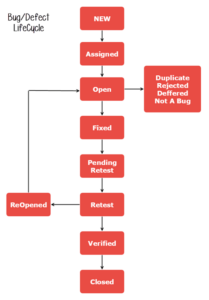Bug Life Cycle of Champ
What is Defect Life Cycle? How can we use it?
Defect Life Cycle or Bug Life Cycle in software testing is the specific set of states that a defect or bug goes through in its entire life. The purpose of the Defect life cycle is to easily co-ordinate and communicate the current status of the defect which changes to various assignees and makes the defect fixing process systematic and efficient.
At the moment we are using https://ticketdesk.champsoft.com/ to track the bugs.

Defect Status or Bug Status in defect life cycle is the present state from which the defect or a bug is currently undergoing. The goal of defect status is to precisely convey the current state or progress of a defect or bug in order to better track and understand the actual progress of the defect life cycle.
The number of states that a defect goes through varies from project to project. Below lifecycle diagram, covers all possible states
- New: When a new defect is logged and posted for the first time. It is assigned a status as NEW.
- Assigned: Once the bug is posted by the tester, the lead of the tester approves the bug and assigns the bug to the developer team. Generally this will do by the project manager in Champ IT solutions.
- Open: The developer starts analyzing and works on the defect fix
- Fixed: When a developer makes a necessary code change and verifies the change, he or she can make bug status as “Fixed.”
- Pending retest: Once the defect is fixed the developer gives a particular code for retesting the code to the tester. Since the software testing remains pending from the testers end, the status assigned is “pending retest.”
- Re-test: Tester does the retesting of the code at this stage to check whether the defect is fixed by the developer or not and changes the status to “Re-test.”
- Closed: Tester does the retesting of the code at this stage to check whether the defect is fixed by the developer or not and changes the status to “Re-test.” Once the tester confirm the re-test as close it will assign into Project manager’s name. The particular project manager should assign the close bug to the developer who did the mistake and close.
Summary – In this process the developer, tester and project manager are the key roles. The project manager should assign the bug to the particular developer after assigning to their name. Once the bug is fixed, the project manager should select the developer who is responsible for the defect and assign the bug to their name and close. In this case, the bug count to the particular developer will display in Mantis.
I’m not sure where you are getting your information, but good topic. I needs to spend some time learning more or understanding more.
Thanks for fantastic info I was looking for this info for my mission.